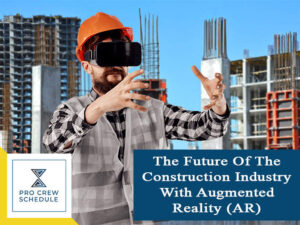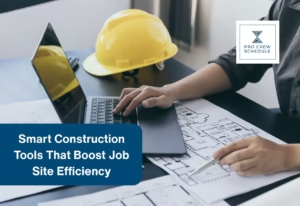For decades, construction has been one of, if not the least, digitalized industry. Because it was, and still is, heavily reliant on human labor, technology has not been efficiently integrated to it– heavy duty vesicles were the most significant thing to hit the industry to improve productivity.
That is until the 21st century produced a landslide of technological advancements that have progressed the construction industry in several ways. Small innovations like construction scheduling software and subcontractor scheduling software are still some of the best tools ever introduced and have significantly improved project management. With platforms like Pro Crew Schedule, managers and contractors can ensure that the project flows efficiently and effectively. They can supervise their crew with a builder schedule and store important documents all in one tool.
On a larger scale, the industry has been experiencing a surge of technological advancements. One of which is the integration of augmented reality.
What is Augmented Reality?
Augmented reality, or AR, is an experience where the physical world is enhanced with added digital information layers, such as sounds, graphics, and other visuals. Designers have created AR to allow the digital content to respond in real-time to any changes the user’s environment undergoes, usually movement.
Augmented Reality vs. Virtual Reality vs. Mixed Reality
The terms augmented reality, virtual reality, and mixed reality are often interchanged. While they all serve the same purpose, which is to alter reality, they all have distinctive features.
AR – Via a digital screen, users can experience the digital elements put into the real world before them. AR often has limited interactivity between users and elements.
VR – Instead of bringing digital objects to the real world, the user is immersed in a different reality, essentially replacing the physical reality. This is usually done via a VR headset and users can interact with the “new” reality.
MR – With elements anchored to a real environment, MR blends AR and VR in such a way that it allows digital objects to interact with the physical world.
AR Applications in Construction
From being the least digitalized industry, construction is now slowly embracing what modern technology has to offer. Whether it’s small innovations like project management tools that have immensely helped managers or larger devices like robots and automated vehicles that have upped productivity, today’s technology has changed the industry for the better. Even if it’s still in its early stages, augmented reality has already proven to be an exceptionally beneficial construction tool.
1. Planning projects
In the past, 2D projects were a staple in construction projects and were vital in the planning and designing phase. Today, however, modern technology has developed ways that let designers and engineers create completely interactive, collaborative models with great detail.
AR technology, such as Building Information Modeling (BIM) and advanced 3D modeling software, has innovated the designing and planning process. It allows users to virtually take walkthroughs in buildings that are still under construction and see how alterations can be incorporated without causing delays and other issues.
This kind of technology gives managers, contractors, and engineers the ability to visualize the effects of any changes in real-time. This will then, in turn, help determine mistakes and immediately answer them, minimizing any project risks and guarantee everyone is one the same page.
2. Manuals and training
With many heavy machinery and complicated tools to operate, construction can be confusing if thrust into it blindly. That’s why training is held to teach workers how each equipment is used, which usually takes hours. Also, physical training might pose some safety risks because receiving them has little to no knowledge of the matter.
Luckily, AR can provide direct instruction and suitably act. Consequently, downtime is reduced, instructions are more intuitive, and training costs are lower. Plus, workers can be trained in a safe environment where they can learn about operating heavy machines without the risk of injury.
3. Inspection
More often than not, the inspection process needs at least two people and is manually done. But with AR, inspectors can accurately align and compare a BIM model with the structure in construction. Additionally, they can take pictures, retrieve notes from sites, all on-demand. AR is especially helpful in easily recognizing sites, problematic areas, and potential concerns.
4. Get project information in real-time.
While best construction management software is an absolute game-changer for storing documents and information, AR does it on a whole different level– it can make all digital documentation and information appear in the physical world.
For example, the location of pipes, outlets, switches, and the like can be directly accessed and superimposed onsite and can easily be toggled on and off. This method of retrieving information helps field workers in effectively monitoring and comparing the structure plan against the actual structure and make sure of its successful completion.
On top of being a useful information database, AR adds another management level by virtually showing the building’s progress compared to its schedule. This way, managers can see if they are behind schedule and make adjustments to get back on track in real-time.
5. Collaboration with teams
Construction is not a one-person show; it is an industry where teamwork and collaboration are of utmost importance. Unfortunately, there will be times when contractors and managers will need to be onsite but can’t. Now, with AR, they can virtually and remotely inspect work sites like they were there. AR allows team collaboration to determine problems, find solutions, and fix the errors in real-time without waiting for decision-makers to be physically there.
6. Underground construction
There are high safety risks when working construction underground. For example, when laying cables and pipes, workers might hit a gas line, damage utilities, or even cause a massive explosion.
Alternatively, AR reduces that risk as it can provide all the vital information before getting started on work.
7. Onsite project modification and renovation
As with anything, construction projects don’t always go according to plan and frequently go through some changes. VR allows designers to input any changes required on the virtual model without touching the physical structure yet.
Applying the virtual model changes first lets them see if the modifications are doable and the best course of action for the project, minimizing guesswork, downtime, and mistakes.
The Reality of Augmented Reality (Benefits and drawbacks)
AR Benefits in Construction
A. Reduces rework time and increases efficiency
In an industry where projects take a significant amount to time to build, efficiency is a priority. Fortunately, AR apps offer many features that improve efficiency, like making and exploring BIM models, adjusting the construction schedule, and getting ahead of logistics planning.
In the construction phase, AR helps field workers quickly identify any overlaps and avoid rework. Plus, upon seeing the layout of utilities, parts can be prefabricated with accuracy and precision.
B. Improved collaboration and project management
It was previously mentioned that AR lets contractors who can’t onsite be virtually and remotely present. In addition to that, it can strengthen the client-contractor relationship.
The client can see the building’s complete design before actual construction even begins, allowing them to make desired changes and smoothen out any misunderstanding.
That idea also goes the same for inspectors. AR overlay helps them with their inspections more effectively, spotting problems and solving them faster, minus the hassle of printed blueprints and communication delays.
C. Automated and accurate measurements
Measurements in construction are critical– one miscalculation could set the entire project back.
Some AR tech, like gear and wearables, can measure physical elements of space with accuracy. By determining the space’s dimensions, like its height, depth, and width, contractors can comprehensively picture what the structure will look like. Other than that, they can also precisely determine the specifics of resources, such as labor hours and needed materials.
D. Cost-saving
Part of a successful construction project includes staying within the budget. So, monitoring expenses is a critical job for project managers. AR can assist in significant cost-saving by increasing labor productivity and improving safety. For example, workers are more likely to work better if they use AR wearables that show them the tasks that need to be done and when they should be completed. As a result, timelines will be met, resources are used appropriately, and there will be no lack of materials.
AR Drawbacks in Construction
Safety
While safety is an advantage improved by AR, it is also one that experiences drawbacks.
While on the site, workers, managers, and visitors are required to wear a hard hat to protect them from falling objects and debris. Unfortunately, some AR glasses hinder its user from wearing a hard hat while using the device.
In addition to that, being immersed with AR might pose a danger as users might be too distracted to realize where they are. They might fail to see a hole and fall into it or notice a crane’s hook right in front of them.
Effects of unstable Internet connection
To get the full advantages of AR, one must have a stable Internet connection. This usually lacks in remote locations. Now, while some AR apps can still work even offline, real-time collaboration is something that cannot be done.







